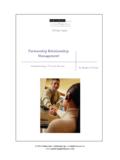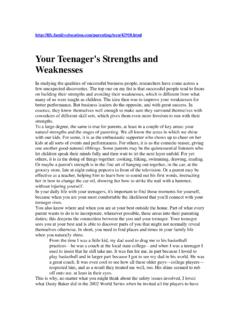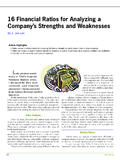Transcription of Leadership Strengths Can Translate to …
1 White Paper Leadership Strengths Can Translate to Communication weaknesses By Stephen M. Dent Leadership Strengths Can Translate to Communication weaknesses 2 Introduction It is human nature to rely on one s Strengths , especially in times of change. This tendency is certainly prominent in leaders, as their Strengths are often the character traits that caused others to recognize them as leaders. Nevertheless, sometimes our Strengths what we do best are not the best behaviors to bring forth the desired outcome in particular situations; they may, in fact, impede successful outcomes. In such instances, the leader s Strengths become weaknesses . Partnership Continuum, Inc. conducted an international study in 2006 of the partnering behaviors and effectiveness of 22 individuals deemed leaders in their respective workplaces. Partnering two or more people working together to accomplish a goal or task while building trust and a mutually beneficial relationship is an essential Leadership skill.
2 In the study, each leader s effectiveness was rated by a group of the individual s peers, superiors, and subordinates (referred to hereafter as secondary participants) in three primary aspects: Strengths Challenges Suggestions for improving skills A genuine leader is .. a molder of consensus. Martin Luther King, Jr. The study clearly revealed that three particular character traits that are Strengths of leaders are associated with specific weaknesses in communication. Given the fact that the role of a leader is to inspire confidence, influence others as to the direction to pursue in initiatives, and motivate others to achieve goals, strength in communication is essential to Leadership success. This white paper discusses the study s findings in the phenomenon of Strengths that become weaknesses in communication skills. It also provides suggestions for improving communication skills. 2007 Partnership Continuum, Inc. All Rights Reserved. Leadership Strengths Can Translate to Communication weaknesses 2 Three Areas of Leadership strength In every case, the study s secondary participants clearly identified the Strengths of the leaders whose effectiveness they ranked in the study.
3 The area of strength for nearly one half (46%) of the 22 leaders was expertise and knowledge. As Exhibit 1 illustrates, a determination to succeed and people skills were the other leaders areas of strength . Exhibit 1 Primary Areas of strength of LeadersExpertiseDeterminationPeople Skills46%36%18% Partnership Continuum, Inc. All Rights Reserved. The study found that the secondary participants viewed only three of the 22 leaders as having more than one dominant area of strength . Of those three leaders with two areas of strength : Two were viewed as having Strengths in the areas of expertise and determination to succeed One was viewed as having Strengths in expertise and people skills. The study also revealed that each of the leaders viewed their Strengths as the same characteristics cited by the secondary participants about the leaders. 2007 Partnership Continuum, Inc. All Rights Reserved. Leadership Strengths Can Translate to Communication weaknesses 3 Responses in the study yielded profiles of traits among leaders within the three areas of strength .
4 (See Exhibit 2). Exhibit 2 Partnership Continuum, Inc. All Rights Traits within Areas of strength Area of strength : People Skills Open and honest Warm; friendly approach; approachable Good listening skills Ability to connect with different personalities Outgoing nature Easy going Concern for others views; caring attitude Encourages others Gets along well with everyone Collaborative Maintains a positive attitude Area of strength :Determination to Succeed Consistently delivers results Drive; enthusiasm Ability to identify the root of a problem Reliable Sees things through to completion; does what she says she will do Drives change forward Strong work ethic Can do attitude Persistent Creative approach to solving problems; thinks out of the box for solutions Area of strength : Expertise Intelligent Organizational skills Depth and breadth of subject matter knowledge Professional Applies robust knowledge to solve problems Knows how the organization runs Dependable.
5 Responsible Strategic Confident Competitive Dedicated Ability to overcome obstacles 2007 Partnership Continuum, Inc. All Rights Reserved. Leadership Strengths Can Translate to Communication weaknesses 4 Leadership and Communication Bruce Mazlish, who authored Leader and Led, Individual and Group, in Essays in Psychohistory, wrote, The organization created by the leader allows for the personal development of the followers. Along the same vein, American activist Ralph Nader stated, The function of Leadership is to produce more leaders, not more followers. Leaders provide meaning and purpose in a given situation. They influence people to get on board and move in the same direction. Leaders are also agents of change, helping others decrease their level of resistance to change. Thus, having good communication skills is one of the most important qualities of an effective leader. Profiles of Leaders Communication Traits While the Partnership Continuum study s secondary participants praised all 22 leaders in many respects, the study found that the secondary participants often perceived that effective communication is a challenge for the leaders.
6 The study findings yielded profiles of communication characteristics among leaders within the three areas of strength . Exhibits 3, 4, and 5 list the primary comments of secondary participants about the 22 leaders manner of communicating with others. As these exhibits illustrate, the study found that leaders who share traits in a particular area of strength also share similar communication traits. Exhibit 3 Leaders Communication Traits Reluctance to share views in discussion groups; does not share ideas with team members Does not listen to team members Communications are not frequent enough Communications are not well structured Does not praise team members or employees Not good at giving clear directions Not good at giving feedback Area of strength : Expertise 2007 Partnership Continuum, Inc. All Rights Reserved. Partnership Continuum, Inc. All Rights Strengths Can Translate to Communication weaknesses 5 The communication traits for a leader whose area of strength is expertise reflect the outcomes of the leader s dominant traits in the area of strength : confident, competitive, and the ability to overcome obstacles.
7 Although this type of leader possesses knowledge that is highly valuable to the organization and essential in developing expertise in team members, the leader s manner of communication can cause people not to follow the influence of the leader. Additional responses of secondary participants describe leaders whose strength lies in expertise as displaying the following behaviors, which result in challenges for the team or organization: Communicates frustration with team members differences in performance Does not influence staff on the fact that change will be good for them Needs to soften approach to team and express appreciation for effort even when results are not what was wanted Often too aggressive and overbearing in communicating with team members Exhibit 4 Leaders Communication Traits Does not seek others opinions Reluctant to share views with others Reporting is not open enough to reveal key issues Does not take time to listen Communicates primarily only what is required Talks enthusiastically.
8 Tends to be over exuberant and not calm Does not talk in a manner that builds relationships Does not take a dispassionate view in discussions Lacks a collaborative, inclusive style of communicating Area of strength : Determination to Succeed Partnership Continuum, Inc. All Rights Reserved. 2007 Partnership Continuum, Inc. All Rights Reserved. Leadership Strengths Can Translate to Communication weaknesses 6 The communication traits for a leader whose area of strength is a determination to succeed reflect the outcomes of the leader s dominant traits in the area of strength : consistently delivers results, ability to identify the root of a problem, and a can do attitude. While a determination to succeed is an admirable quality on an individual level, it can be a hindrance in leading others if it results in relying on oneself for performance rather than taking an inclusive, collaborative approach with others. Additional responses of secondary participants describe leaders whose strength lies in a determination to succeed as displaying the following behaviors, which result in challenges for the team or organization: Can be overbearing Can be adversarial Not accepting of others efforts when achievements do not meet expectations Lacks tolerance, patience, and diplomacy Does not take a trusting approach Does not communicate in a way that facilitates getting to know others on a personal level Exhibit 5 Leaders Communication Traits Very good listening skills Communications are delivered in caring manner but often key lack information Does not show confidence when delivering messages Hesitant about asserting a differing opinion.
9 Often prefers to just go along with others on the team Not good at giving pointers to staff and team members Not good at providing honest feedback Hesitant to rock the boat Tends to avoid conflict Area of strength : People Skills Partnership Continuum, Inc. All Rights Reserved. 2007 Partnership Continuum, Inc. All Rights Reserved. Leadership Strengths Can Translate to Communication weaknesses 7 The communication traits for a leader whose area of strength is people skills reflect the outcomes of the leader s dominant traits in the area of strength : friendly approach, concern for others views, and gets along well with everyone. While employees and teams tend to want to follow leaders who are personable, they still need a leader who will provide guidance in setting expectations, achieving goals, and working through conflict and change events. Additional responses of secondary participants describe leaders whose strength lies in people skills as displaying the following behaviors, which result in challenges for the team or organization: Frequently reorganizes without explaining to staff the reason for change Not willing to push others to get the job done Frequently doesn t follow up to make sure decisions are acted upon Needs to be more succinct Doesn t say no Not forceful in knocking down barriers Developing Effective Communication Skills The answer to the age old question of whether leaders are born or made is evident in this study.
10 While the 22 leaders possess certain qualities (such as expertise, determination to succeed, and people skills) that caused them to rise to Leadership positions, the way they apply these qualities is not always effective. Great Leadership , for example, creates momentum, enabling others to achieve more than before. It opens people up to possibilities, aligns them with others, and helps them commit to goals and initiatives. For the most part, the qualities and areas of strength the 22 leaders in this study naturally possess cause them to naturally communicate in a manner that decreases momentum, does not help others open up to possibilities, causes them to work more as individuals than aligned team members, and does not help them understand enough about goals and initiatives to commit to them. Leadership skills are learned. More importantly, effective leaders understand that each situation is unique and they need to apply different skill sets to a particular situation.











